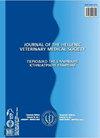2016-2020年阿尔巴尼亚地拉那地区猫中拟除虫菊酯中毒病例监测
IF 0.4
4区 农林科学
Q4 VETERINARY SCIENCES
引用次数: 0
摘要
拟除虫菊酯是一种合成杀虫剂,被广泛用于控制家庭宠物身上的跳蚤和蜱虫。然而,它们的使用也扩展到害虫防治。世界范围内用于保护宠物的产品是液体形式,包括定点、洗发水和喷雾。应密切注意在宠物,特别是猫身上正确使用这类杀虫剂。正如许多研究已经表明的那样,意外或不当使用这些产品会引发严重的健康问题,甚至对猫来说是致命的。本论文的目的是对2016-2020年期间阿尔巴尼亚地拉那几家诊所的47例患拟除虫菊酯中毒的猫进行回顾性研究。兽医诊所的记录被仔细审查,仅包括拟除虫菊酯类中毒的具体病例,为本研究的目的。47只猫的主要临床症状包括震颤/肌肉抽搐(37只猫;76.6%),癫痫发作(18%;38.3%),感觉亢进(19;40.43%),唯心主义(13%;27.66%),共济失调(11;23.4%),蝇蛆病(10;21.28%)。在47个病例中,有7只(14.9%)接受治疗的猫没有存活。除2只猫在接受治疗后死亡外,31只猫(65.96%)在快速干预后的结果是稳定的。然而,多达16只(34.04%)的猫在接受治疗后幸存下来,而只有5只猫(31.25%)死亡。针对宠物主人的意识运动、主人教育、适当的产品标签和与兽医的咨询可能有助于在未来消除这一问题。本文章由计算机程序翻译,如有差异,请以英文原文为准。
Monitoring cases of pyrethroid intoxications in cats in Tirana region, Albania during 2016-2020
Pyrethroids are synthetic insecticides which are being widely used to control fleas and ticks in household pets. However, their use extends to pest control as well. Products used worldwide to protect pets are in liquid form and comprise spot-ons, shampoos, and spray. Close attention should be paid to proper usage of such insecticides in pets, particularly in cats. As already indicated by many studies, accidental or improper usage of such products can trigger severe health problems even proving fatal in cats. The objective of the current paper is to undertake a retrospective study of a total number of 47 cases suffering from pyrethroid intoxication in cats across several clinics in Tirana, Albania during the period 2016-2020. Records from the veterinary clinics were closely scrutinized with only specific cases of pyrethroid intoxication being included for the purposes of this study. The main clinical signs which were noticed in 47 cats included symptoms such as tremor/muscle fasciculation (37 cats; 76.6%), seizures (18; 38.3%), hyperaesthesia (19; 40.43%), ptyalism (13; 27.66%), ataxia (11; 23.4%), mydriasis (10; 21.28%). Out of 47 cases, 7 or 14.9 % of the treated cats did not survive. The outcome was solid after rapid interventions in 31 (65.96%) cats with the exception of 2 cats which did not survive dispide receiving treatment. Whereas as many as 16 (34.04%) of cats, having being taken late to the clinics, survived upon receiving treatment, while as few as 5 cats (31.25%) died. Awareness campaign targeting pet owners, owner education, appropriate product labelling and consultations with veterinarians may help eliminate this problem in the future.
求助全文
通过发布文献求助,成功后即可免费获取论文全文。
去求助
来源期刊

Journal of the Hellenic Veterinary Medical Society
VETERINARY SCIENCES-
CiteScore
0.60
自引率
0.00%
发文量
83
审稿时长
>12 weeks
期刊介绍:
The Journal of the Hellenic Veterinary Medical Society (J Hellenic Vet Med Soc) is a quarterly peer-reviewed journal that publishes articles in all aspects of veterinary science and related disciplines. It is published by the Hellenic Veterinary Medical Society and is indexed in the Web of Science and in Scopus.
There are no publication fees in the journal. Authors considering submitting manuscripts for evaluation and publication are requested to read carefully the instructions for authors and fully comply with them.
Non-complying manuscripts may be returned to the corresponding author for formatting.
 求助内容:
求助内容: 应助结果提醒方式:
应助结果提醒方式:


